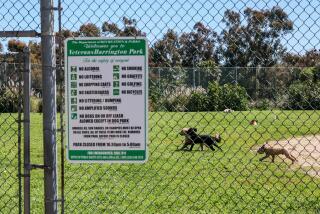Cat’s Out of the Bag: Animal Care Matters
Let’s face it, most of us don’t give animals much thought unless they’re our own. I don’t have any pets, so I seldom think of them at all.
When animals make news, it’s usually because a kooky animal-rights activist has done something off the charts.
Given the tendency to dismiss “animal news,” is there such a thing as a truly historic moment for animals?
Some Orange County animal activists think so. And they think the time is now.
Robert Newman is one.
The last time I talked to Newman, he was saying it was good that his high-profile Newport Beach client Tina Schafnitz was going to jail for selling cocaine.
In my book, that made him an interesting guy with credibility.
Defending the rich and famous is a good gig, so I was surprised to find out that Newman also goes to bat for four-legged clients.
That’s brought him back into the news, as a mini-scandal at the county’s animal shelter has cost the chief veterinarian his job and most likely will produce a new director in the months ahead. Recently, dozens of cats have died in a distemper outbreak that animal advocates say is just the culmination of mismanagement and inadequate care at the shelter.
Newman, who’s on the advisory board to the county’s shelter, says Orange County has done a crummy job over the years caring for its stray animal population. Surrounding counties put us to shame. While they’ve routinely spayed and neutered animals before releasing them, Orange County only adopted the policy because of a new state law.
“The bottom-line problem with animals is overpopulation,” Newman says. “That’s not the shelter’s fault, but in the more progressive counties, they’ve been spaying and neutering every animal that leaves the shelter.”
The county’s shelter problems are long-standing and numerous, Newman says, but he’s optimistic that the county may finally be getting the right people in positions of power.
Between the County and the Fringe
Now if only he could control the extremists, who do more harm than good in marshaling public support.
“It carries so much of a stigma with it,” Newman says of animal activism. “I don’t consider myself an animal activist, but an animal advocate. My biggest fear in being involved was that I would not be taken seriously, because I’ve been summarily dismissed once people hear I’m involved in advocacy for animals.
“What makes headlines is people who throw red paint on someone wearing fur. That, or some little old lady in San Clemente who’s got 37 cats and doesn’t want to get rid of them. Those people hurt the movement.”
Newman estimates the fringe element in local animal activism at 5%. But coupled with a county bureaucracy
that mainstream animal advocates routinely fight, the losers have been the animals.
Kay Bennett of North Tustin says amen to that. She’s one of the county’s best-known animal advocates and her 36 years of involvement include the occasional trapping of wild cats that the county wouldn’t go after.
She thinks the county is about to have a breakthrough. So much so, she says, that she’s scared. Scared to hope that it’s true.
“That’s because I’ve seen some of these things happen before,” she says, “and as soon as there’s no more bad publicity, they go back to ignoring us. . . . It’s too bad it took a catastrophe to bring them to their knees and make them do what should have done years ago.”
However, she says, “This is the first time I’ve ever seen them go this far. I also think the veterinarian community has joined hands with the humane community.”
The ongoing battle may be in convincing the public at large that animal care matters and that it isn’t the province of radicals.
I ask Bennett how she plans to fight that one.
“You can fight it by telling it as it is,” she says. “The animals feel pain as we feel pain, and they rely on human beings. And they give love. I’ve seen animals that have been beaten and horribly mistreated who then lick the hand of the person who has done it. You can’t get the sort of trust and compassion from human beings that you can from animals.”
Dana Parsons’ column appears Wednesday, Friday and Sunday. Readers may reach Parsons by calling (714) 966-7821,
by writing to him at The Times Orange County Edition, 1375
Sunflower Ave., Costa Mesa, CA 92626, or by e-mail at dana.parsons@latimes.com.


